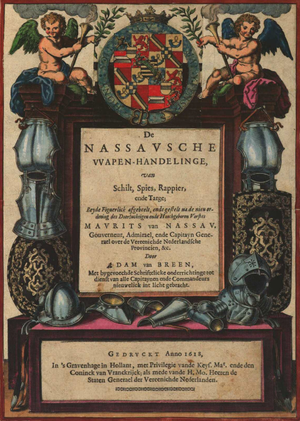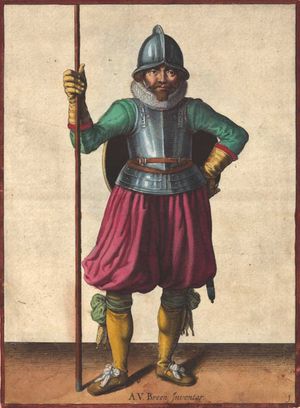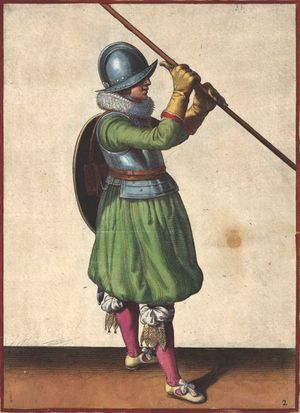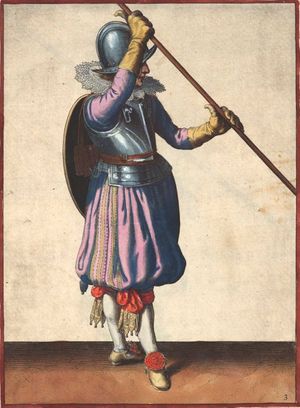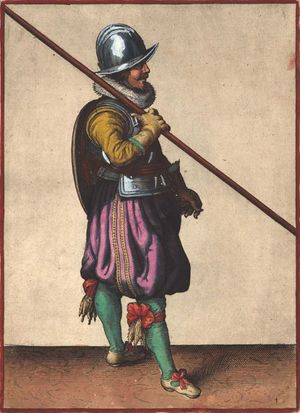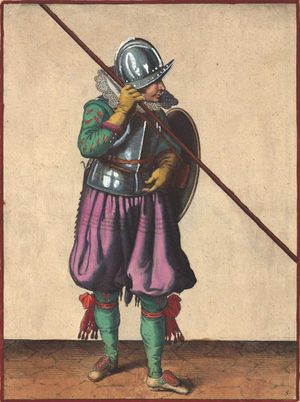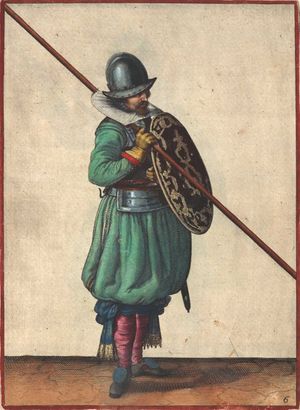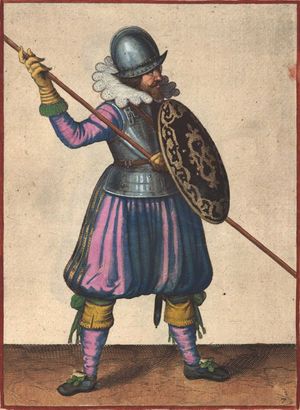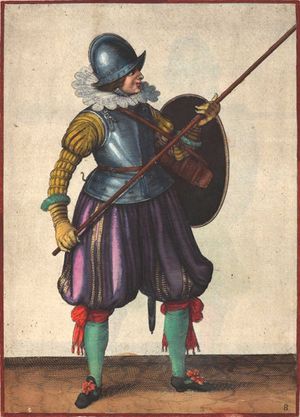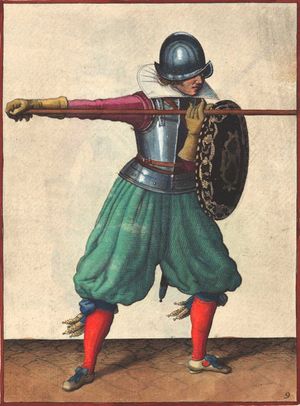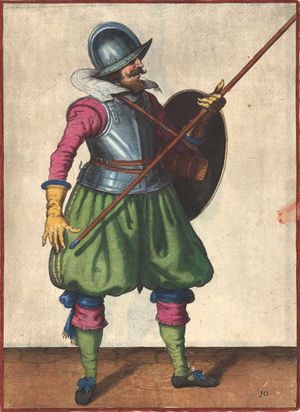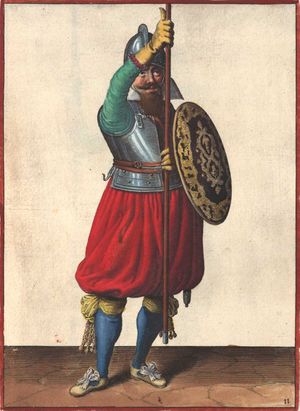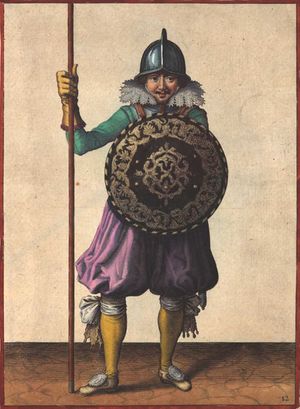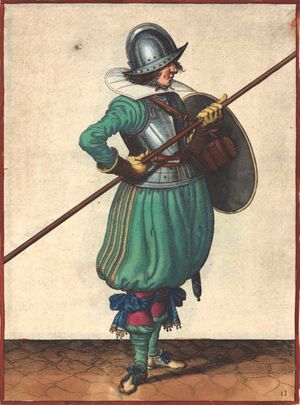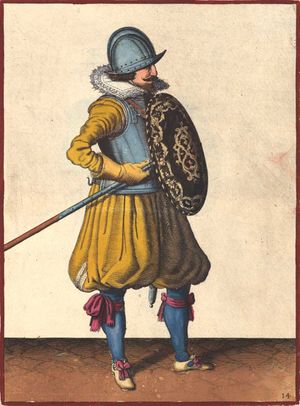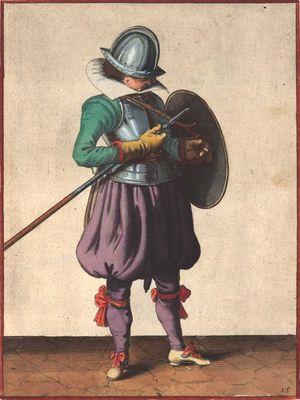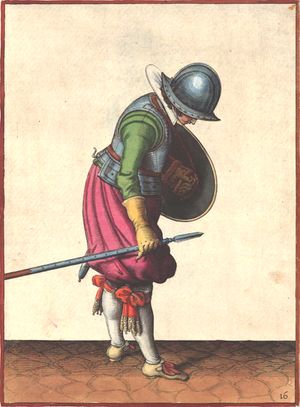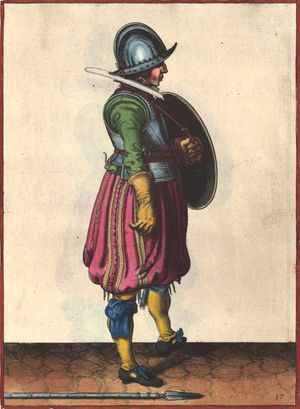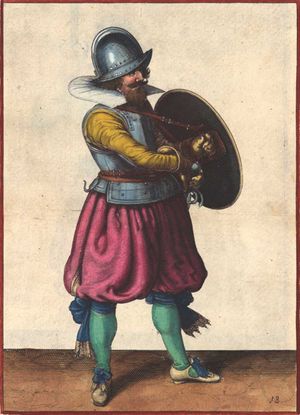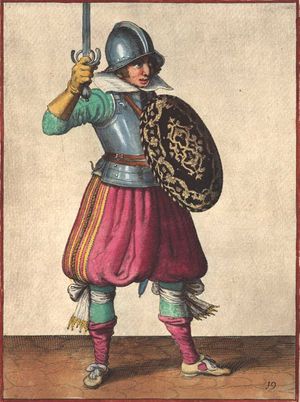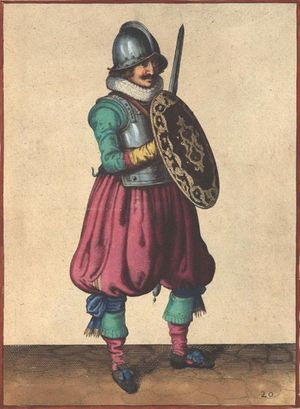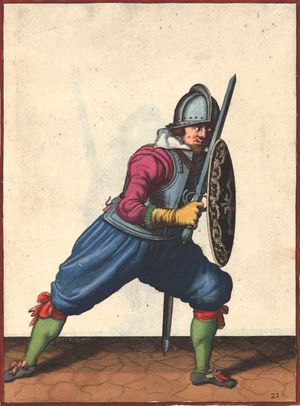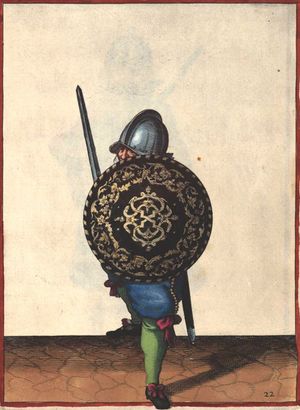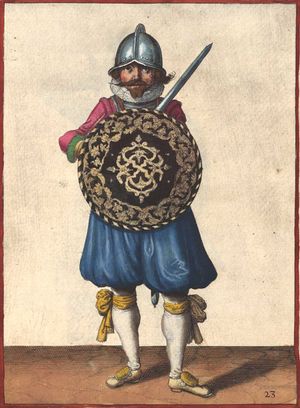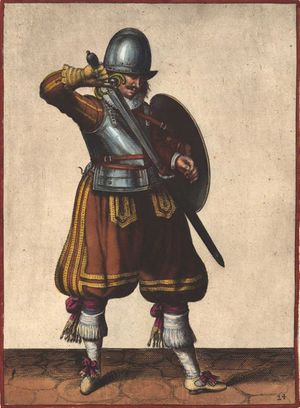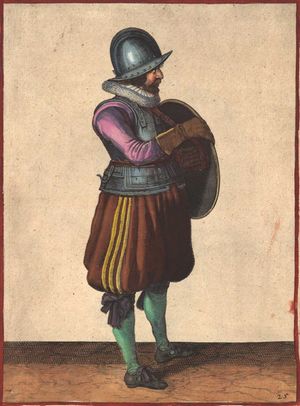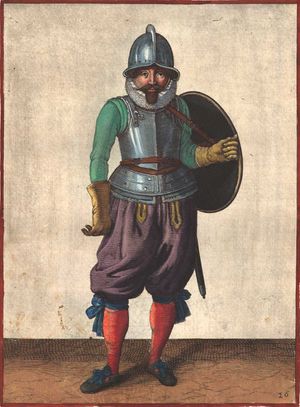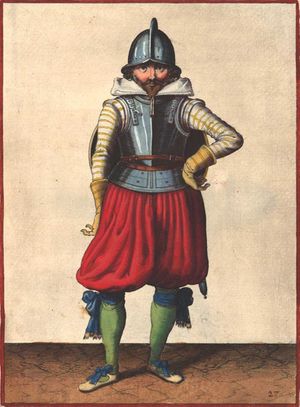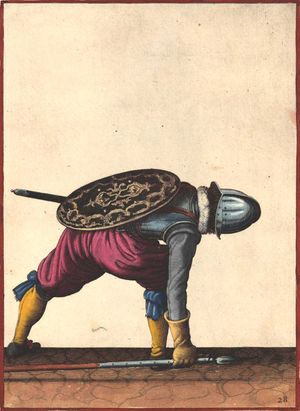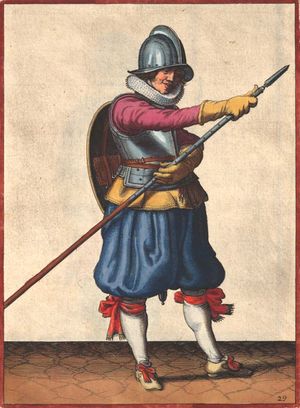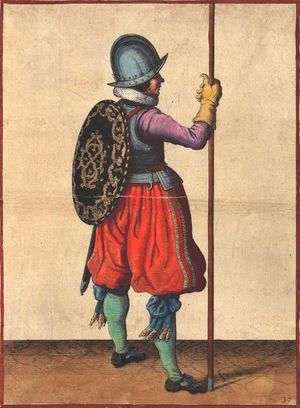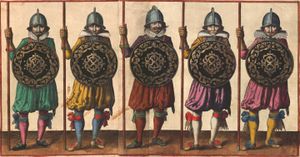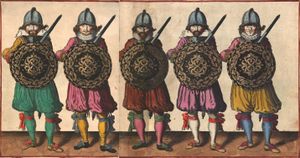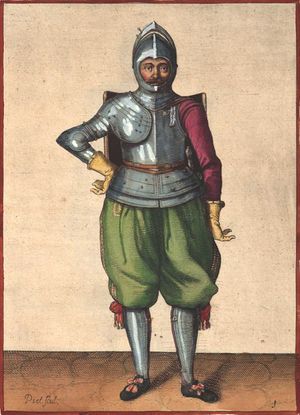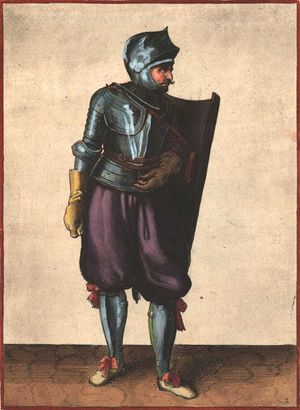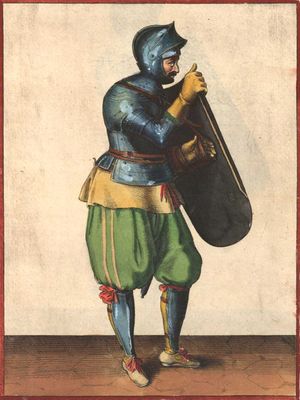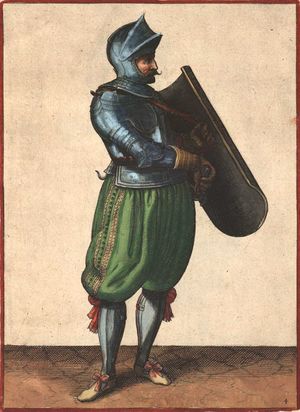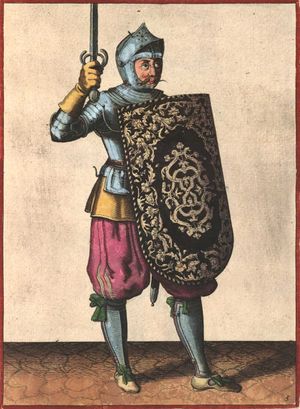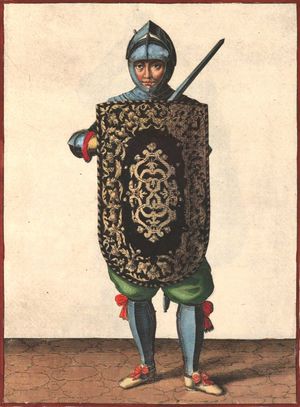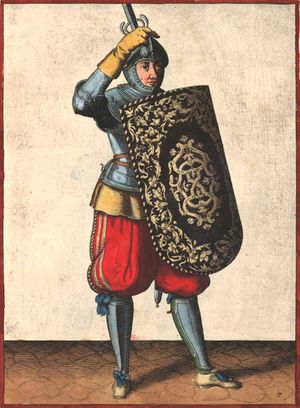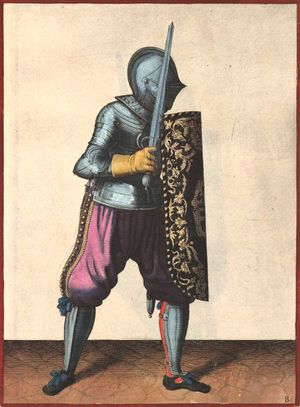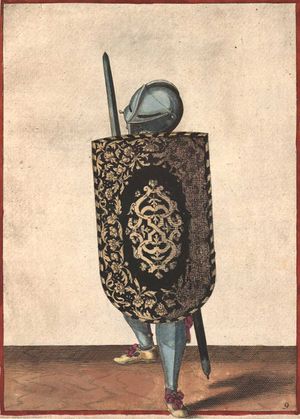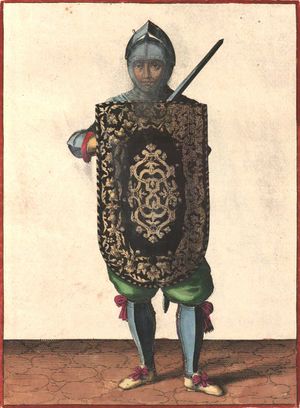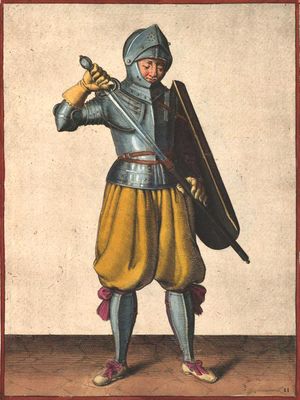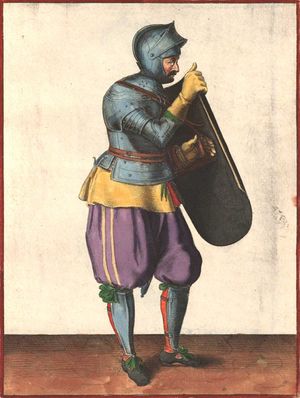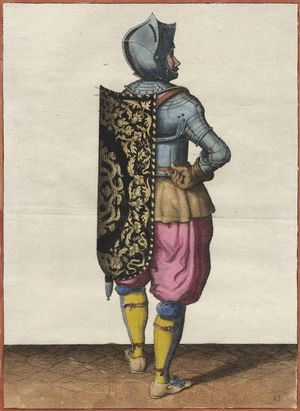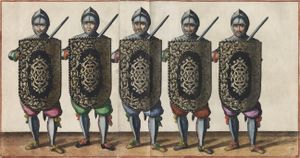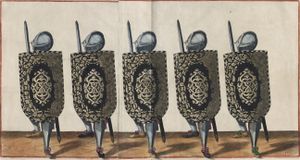|
|
You are not currently logged in. Are you accessing the unsecure (http) portal? Click here to switch to the secure portal. |
Difference between revisions of "Adam van Breen"
| Line 52: | Line 52: | ||
In 1617, van Breen created a series of prints illustrating militia drill with the pike and shield, and the sword and shield. They were published in 1618 in the Hague, Netherlands, by [[Aert Meuris]] under the title ''[[De Nassavsche Wapen-Handelinge (Adam van Breen)|De Nassavsche Wapen-Handelinge van Schilt, Spies, Rappier end Targe]]'' ("On the Weapon-Handling of Nassau with Shield, Spear, Rapier, and Target"); also included were anonymous descriptions and commentary in Dutch, French, and German editions. | In 1617, van Breen created a series of prints illustrating militia drill with the pike and shield, and the sword and shield. They were published in 1618 in the Hague, Netherlands, by [[Aert Meuris]] under the title ''[[De Nassavsche Wapen-Handelinge (Adam van Breen)|De Nassavsche Wapen-Handelinge van Schilt, Spies, Rappier end Targe]]'' ("On the Weapon-Handling of Nassau with Shield, Spear, Rapier, and Target"); also included were anonymous descriptions and commentary in Dutch, French, and German editions. | ||
| − | + | In this concordance, the text of 1625 English publication has been placed in the first transcription column owing to the face that a modernized English version has not yet been produced from one of the original languages. (Unfortunately, the Bodleian Library's copy, from which this transcription was made, is missing several pages.) The text of the other languages has been rearranged to match the English where applicable, but can be read in its original order on the transcription pages. | |
{{master begin | {{master begin | ||
| Line 96: | Line 96: | ||
| | | | ||
| {{section|Page:Le Maniement d’Armes De Nassau (Adam van Breen) 1618.pdf/5|1|lbl=1}} | | {{section|Page:Le Maniement d’Armes De Nassau (Adam van Breen) 1618.pdf/5|1|lbl=1}} | ||
| − | | | + | | {{section|Page:De Nassavsche Wapen-Handelinge (Adam van Breen) 1618.pdf/89|1|lbl=77}} |
|- | |- | ||
| Line 199: | Line 199: | ||
| | | | ||
| <p>'''The exercise of armes ''wherein lively''''' figures is showne the Right Use and perfect manner of Handling the Buckler Sword and Pike with the words of Command and Brefe Instructions correspondent to every Posture.</p> | | <p>'''The exercise of armes ''wherein lively''''' figures is showne the Right Use and perfect manner of Handling the Buckler Sword and Pike with the words of Command and Brefe Instructions correspondent to every Posture.</p> | ||
| − | | | + | | {{section|Page:De Nassavsche Wapen-Handelinge (Adam van Breen) 1618.pdf/17|top|lbl=5}} |
| {{section|Page:Le Maniement d’Armes De Nassau (Adam van Breen) 1618.pdf/7|top|lbl=3}} | | {{section|Page:Le Maniement d’Armes De Nassau (Adam van Breen) 1618.pdf/7|top|lbl=3}} | ||
| − | | | + | | {{section|Page:De Nassavsche Wapen-Handelinge (Adam van Breen) 1618.pdf/92|top|lbl=80}} |
|- | |- | ||
| Line 211: | Line 211: | ||
<p>In the first is showne how the Soldier standing in Order with his Pike shall carry the Buckler behind on his backe, and plant the Pike against his Right foot his Arme a little bended and his hand about the height of his eyes.</p> | <p>In the first is showne how the Soldier standing in Order with his Pike shall carry the Buckler behind on his backe, and plant the Pike against his Right foot his Arme a little bended and his hand about the height of his eyes.</p> | ||
| − | | | + | | {{section|Page:De Nassavsche Wapen-Handelinge (Adam van Breen) 1618.pdf/17|1a|lbl=-}} |
| {{section|Page:Le Maniement d’Armes De Nassau (Adam van Breen) 1618.pdf/7|1a|lbl=-}} | | {{section|Page:Le Maniement d’Armes De Nassau (Adam van Breen) 1618.pdf/7|1a|lbl=-}} | ||
| Line 217: | Line 217: | ||
{{section|Page:Le Maniement d’Armes De Nassau (Adam van Breen) 1618.pdf/7|1b|lbl=-}} | {{section|Page:Le Maniement d’Armes De Nassau (Adam van Breen) 1618.pdf/7|1b|lbl=-}} | ||
| − | | | + | | {{section|Page:De Nassavsche Wapen-Handelinge (Adam van Breen) 1618.pdf/92|1a|lbl=-}} |
|- | |- | ||
| Line 616: | Line 616: | ||
| | | | ||
| <p>'''The perfect manner of handling ''The sword and Target''' Set forth in Lively '''Figures''' with the words of Command and Breife Instructions correspondent to every Posture.''</p> | | <p>'''The perfect manner of handling ''The sword and Target''' Set forth in Lively '''Figures''' with the words of Command and Breife Instructions correspondent to every Posture.''</p> | ||
| − | | | + | | {{section|Page:De Nassavsche Wapen-Handelinge (Adam van Breen) 1618.pdf/21|top|lbl=9}} |
| {{section|Page:Le Maniement d’Armes De Nassau (Adam van Breen) 1618.pdf/71|1|lbl=71}} | | {{section|Page:Le Maniement d’Armes De Nassau (Adam van Breen) 1618.pdf/71|1|lbl=71}} | ||
| − | | | + | | {{section|Page:De Nassavsche Wapen-Handelinge (Adam van Breen) 1618.pdf/92|top|lbl=85}} |
|- | |- | ||
| Line 628: | Line 628: | ||
<p>First in the exercise and use of the Target is showne how the Soldier shall assume his due posture, his Target hanging at his backe, attending further Command from his Captaine.</p> | <p>First in the exercise and use of the Target is showne how the Soldier shall assume his due posture, his Target hanging at his backe, attending further Command from his Captaine.</p> | ||
| − | | | + | | {{section|Page:De Nassavsche Wapen-Handelinge (Adam van Breen) 1618.pdf/21|1a|lbl=-}} |
| {{section|Page:Le Maniement d’Armes De Nassau (Adam van Breen) 1618.pdf/71|2|lbl=-}} | | {{section|Page:Le Maniement d’Armes De Nassau (Adam van Breen) 1618.pdf/71|2|lbl=-}} | ||
| Line 634: | Line 634: | ||
{{section|Page:Le Maniement d’Armes De Nassau (Adam van Breen) 1618.pdf/71|3|lbl=-}} | {{section|Page:Le Maniement d’Armes De Nassau (Adam van Breen) 1618.pdf/71|3|lbl=-}} | ||
| − | | | + | | {{section|Page:De Nassavsche Wapen-Handelinge (Adam van Breen) 1618.pdf/92|1a|lbl=85}} |
|- | |- | ||
Revision as of 21:31, 4 November 2018
| Adam van Breen | |
|---|---|
| Born | 1585 Amsterdam |
| Died | 1642 Norway |
| Spouse(s) | Maria Gelle |
| Occupation |
|
| Nationality | Dutch |
| Genres | Drill manual |
| Language | |
| Notable work(s) | De Nassavsche Wapen-Handelinge van Schilt, Spies, Rappier end Targe (1618) |
| Concordance by | Michael Chidester |
Adam van Breen (Amsterdam, 1585 - Norway, after 1642) was a Dutch artist from the Golden Age. Van Breen was born in 1585, most likely in Amsterdam, and specialized in winter landscapes. He was married in The Hague on 13 February, 1611, to Maertje Castel. In 1612, he became a member of the Guild of Saint Luke (the painter's guild), which membership lasted until 1621. After he went bankrupt in Amsterdam in 1624, he left for Oslo but returned to Amsterdam in 1628. In 1636, he left for Norway again, where he helped decorate the Akershus Castle among other things. He stayed in Norway until his death, some time after 1642. Van Breen was influenced by Hendrick Avercamp and David Vinckboons, he was possibly a pupil of one of them.
Contents
HEMA Contributions
In 1617, van Breen created a series of prints illustrating militia drill with the pike and shield, and the sword and shield. They were published in 1618 in the Hague, Netherlands, by Aert Meuris under the title De Nassavsche Wapen-Handelinge van Schilt, Spies, Rappier end Targe ("On the Weapon-Handling of Nassau with Shield, Spear, Rapier, and Target"); also included were anonymous descriptions and commentary in Dutch, French, and German editions.
In this concordance, the text of 1625 English publication has been placed in the first transcription column owing to the face that a modernized English version has not yet been produced from one of the original languages. (Unfortunately, the Bodleian Library's copy, from which this transcription was made, is missing several pages.) The text of the other languages has been rearranged to match the English where applicable, but can be read in its original order on the transcription pages.
Images |
English Transcription (1625) |
Dutch Transcription (1618) |
French Transcription (1618) |
German Transcription (1618) | |
|---|---|---|---|---|---|
Mars his Feild or The Exercise of Armes |
[Ttl] De Nassausche Wapen-handelinge, van Schilt, Spies, Rappier, ende Targe; Beyde Figuerlick afgebeelt, ende gestelt na de nieu ordening des Doorluchtigen ende Hoochgeboren Vorstes Maurits van Nassau, Gouverneur, Admirael, ende Capitayn Generael over de Vereenichde Nederlandsche Provincien, &c. |
[Ttl] Le Maniement d’Armes De Nassau, avecq Rondelles, Piques, Espees, & Targes; Representez par Figures, selon le nouveau ordre du Tresillustre Prince Maurice de Nassau, Gouverneur, Admiral, & Cappitanie General des Provinces Unies du pays bas, &c. |
Neuwe Nassauwische Waffen-Handlung von Schilt, Spies, Rappier und Targa. Figurlich abgebildet nach der neuw invertirte Ordnung des Durchleuchtigen hochgebornen Fursten und herren, herren Mauritzen, Printzen zu Oranien, Graven zu Nassau, &c. Obristen Velchherren, Admiral, und Capitein General der vereynigten Niederlendischen Provincien: | ||
Door Adam van Breen, Met bygevoechde Schriftelicke onderrichtinge tot dienst van alle Capitaynen ende Commandeurs nieuwelick int licht gebracht. |
Par Adam van Breen, Avecq Instruction par escript pour tons Cappitaines & Commandeurs, nouvellement mis en lumiere. |
Dursh Adam von Breen. Mit beygefeugter schriftlichen underrichtung zu dienst aller Capiteinen und Befelchaberen neuwelich ins licht gebracht. | |||
And are to be sold by Roger Daniell at the Angell in lombard streete |
Gedruckt Anno 1618, In 's Gravenhage in Hollant, met Privilegie vande Keys. Mat (keyserlijcke Majesteit?). ende den Coninck van Vranckrijck; als mede vande H. Mo. (hoog mogende) Heeren de Staten Generael der Vereenichde Nederlanden. |
Imprime Anno 1618, A la Haye en Hollande, avecq Previlege de la Mat. Imperiale, & du Roy Treschristien de France, aussi des Hault & puissans Seigneurs les Estats Generaulx des Provinces Unies du pays bas. Ex Officina Arnoldi Meuris. |
Getruckt Anno 1618. In des Graffen haagen, mit privilegien der Kans. Mat. und des Kōnigs in Francreich, als auch dern Ho. Mōg. Herren Staten general der Veraynigten Niederlanden.
| ||
[1] TOUS AMATEURS DU MANIEMENT DES ARMES ADAM VAN BREEN leur souhaite prosperité & felicité. FLAVIUS VEGETIUS, Autheur ancien, lequel pres que nous eft demeuré, de ceux qui en la langue Latine ont escrit, del’ordre militaire & maniement des Armes des Romains, tesmoigne, mesmes les Histoires denoncent assez clairement: Que les Romains, par non autre voye sont devenu maiftres du tout l’univers, que par le maniement serieux, & exercice continuel des armes. Car que pouvoit (dict l’Autheur susdict) une petite troupe & une poingnee des Romains contre la multitude des Gaulles? Que pouvoient les petits Italiens a l’encontre de ce grands & hault Allemans? Il est assez notoir, que les Espaignols non seulement en nombre, mais aussi en force corporelle leur surpassoient: & que au commencement n’y estoient a accomparer, aux rusees & richesses des Africains, voire, mesmes a la prudence des Grex. Contre tout cela il a esté requis & necessaire, premiere ment a la guerre, d’eslire & entretenir Ieunesse dextre & genereux, & ceux la exercer au vray maniement des armes, par les Campidoctores (tel nom donne Vegetius aux Commandeurs & Offîciers, comme Pedagoges exercees & experimentés aux armes) faire apprendre & enseigner: Les tardiss & nonchalans duement punir, les vertueux & animez recompenser: Finalement d’en faire des hommes belliqueux, le rendre par l’exercice continuelle, robuste & a droict: De forte que estant en Campaigne, rien ne se presenteroit, ou ils sussent bien dressez a tous occurrences, & armees contre tous dangiers: Bien resolu de resister, & leur defendre, ausi prest au besoing d’empoigner l’ennemy sans aucune crainte. |
[77] Allen Liebhabern der Waffenhandelung munscht Adam van Breen Gluck und Heyl | ||||
La science & maniement des armes, engendre & nourrit une generosité au Combat. Il n’y a personne qui no seroit executer en Campaigne, ce qu’il n’auroit appris correctement a la Maison, en forte que l’exercice des armes, pour le bien des Republicques & Villes, occasionne un singulier profit, & prosperité en la Guerre. Vn General d’une Armee executera plus, par une petite troupe des soldats experimentés, qu’avec une grosse armee degens mal dressez. Les Grecx, & specialement les Romains ont remarqué cecy, & ceux qui leur ont succedé, le grand avantaigie qui leur est advenu. |
|||||
Voila non sans raison, que le tres-Illustre Prince Maurice de Nassau, ceste tret-necessaire science des armes, desia decheu, & en mespris, a redressé & estably, d’un singulir zele & affection a la maintenue d’icelle: Nuict & jour sans cesse estudians ce mesme Prince, à l’honorer & augmenter de plusieurs nouvelles & plus necessaires inventions plain de practicques. En facon qu’elle eft la parfaiste & excelente pour le present qu’aucun Prince ou General d’une armee pouroit inventer. Parquoy ce Prince est devenu en grand estime entre tous Princes de l’Europe, voire en admiration entre tous peuples & nations de la terre, ayants cognoissance de ses actions Heroicques, congruant par mesme voix, le los, du grand Duc de Venise, & du Serenissime Senat attribuant a ce Prince, Le plus grand Capitaine de son temps. |
|||||
Or, pour demonstrer l’inclination & la recognoissance que je doibs a un Prince tant noble & illustre. pour progeniture de ceste nouvelle MANIEMENT DES ARMES NASSAUICQUES, ay volu produire & representer au vis, toutes les POSTURES, de la Rondelle, Picque, Espee, Targe, consecutivement toutes fortes des armes legitimes tout ainsi que le Prince pour le present, fait observer a la Compagnie des gardes. A fin que non seulement le Capitaines & Gens de Guerrey se delectent, en contemplant, mais utile a les imiter, ay voulu y adjouster les raisons d’icelles en bref, mais toutesfois instruction necessaire, faisant parler les figures. Quel observation de temps, paroles de commandement aux Soldats, qu’il y a à observer, ce la se monstre icy clairement & par les carracteresen chiphre, commencant de la premiere Figuere, jusques a la derniere. |
|||||
[2] Touchant le changement des armes, est à noter pour le premier, que Les Soldats, avec la Rondelle, sont representes avec les Rondelles, Corselettes sans tachettes, Morlions, Picques, & Espees courtes, autremēt espees d’armes, pendantes a leurs costez, sans ceinture d’attache. afin en telle sorte s’en servir au besoing. Car estants advançez jusques au rangs de leurs ennemis, & ne pouvant manier leurs picques, par l’incommodité de la longeur d’icelles, le quiteront tout aussi tost, empoignant promtemēt leurs rondelles, & espées susdites, pour se defendre, autant que faire se poura & offencer leur ennemis. |
|||||
Secondement, ceux qui seront armés de Targes, sont ausi representés avec leurs armes appertenants avec Targes, Corselets, Casquets, Espees d’armes, ayants une Brassade au bras dextre, & a chasque jambe une greve, ou armure de jambes. Estans doncques ainsi armez de Targes, ayants leurs casquets fermez, en se cachant derriere lesdites Targes, felon la parole du commandement, donneront ainsi fort commodement sur l’Esquadron des picques de leurs ennemis, les rompant facilement, sans recevoir beaucoup de dommage, par ce qu’ils sont armez depuis le sommet de la teste, jusques au plan des piedts, & garni contre les poinctes des picques, par consequent armez à plusieurs autres affaires necessaires. Exercice tres utile & necessaire, voire tres-louable: Ce que tous Princes & Generaux d’une Armee comprendront aisement, sans qu'il soit de besoing d’en discourir davantage, & embellir la chose utile, par beaucoup de paroles ornez. Encore me sault il dire cecy, que les Soldats exercez en cefte arme, n’auront aucune difficulté en marchant, de viser a un chemin dressé, mais seront un chemin par force. |
|||||
Desirant que les fruicts de ces nouvelles exercices puissiont estre si grandes, par les Figures, demonstrations & enseignements de la lettre, comme mon zele & desir a esté, de mettre en lumire ce Livre, DU MANIEMENT DES ARMES NASSAUICQUES. A Dieu soyez, à la Haye, l’An 1618. |
|||||
Remarque des ces motz Rondelle & Targe. Pour accomplissement, me suis addonné au proffit des inexperimentés, parla vraye signification de la Rondelle & Targe. En premier lieu, doibt on sçavoir par ce mot Rondelle, entendre les armes faict en forme d’un essieu du Chariot lequel est tout rond, & de ce facon nommé Rondelle, & ceux qui portent telles armes, Rondelliers. Mesmes les Figures donnent asseze cecy à cognoistre. Les Latins & Grex, donnēt à la rondelle le nom de Clypeus, Aspis, Parma; de laquellé facon Pelta ne differoit guere: Estans la plus grande partie tout rond, par en hault creuse, en forme de deux croisans. Ceste Figure est tiré d’un vieux Marbre à Rome, comme recite Lipsius in Analectis. Que les rondelles ont esté tout rond, Virgilius le tesmoigne 2. AEneidos. ---- clypeique sub orbe teguntur. On pouroit icy porduire plusieurs autres raisons, lesquelles ne sont guere loing à cercher, mais nous les obmettons, pour estre tant plus bref. |
|||||
Pour le second, ce que se nomme Targe, a beaucoup de commun (felon mon advis) avec le Scutum Romain, lequel avoit la forme un peu longe. Le Poëte susdict AEneidos VIII. ----- Scuti protecti corpora longis. Scutum (selon le dire de Livius) estoit le desus, dequoy la poictrine & les espaules furent couverts, les bords unies, & non ronds: pas embas finissant rondastre. Les Rondelles des Africains ne dissembloyent à celles cy, les nommant Cetræ: lesquelles ont en usance entre les Espaignols. Que ces Scuta & Cetræ, ont esté grands & leger, peult on juger des tesmoignages des Autheurs anciens. Des Espaignols dit Livius lib. 31, qu’en couchant & reposant, sur leurs rondelles, passerent la riviere en nageant. Ammianus Marcellinus lib. 16. recite pareil Histoire. De sorte que les anciens ont faict leurs rondelles, d’une matiere leger, soit des cordes entrelascés, 0u bois, ou de branchettes. Les Allemans ont eu aussi telles sortes de rondelles, dequoy Tacitus De moribus Germanorum tesmoigne: Qu’il ni a que CCCC ans, qu’ils estoyent encore entre eux en usance. Tyrol Scotus in Parænesi ad filium Fridebrandum § 30. |
|||||
Da hurt gegen hurte dringet. Cest à dire, poussez rondelle contre rondelle. Il est assez cognu parmy nous, ce que cest d’une claye d’osier. Nous remarquons bien clair, du monumēts que ceste claye, ou cordes entrelascés, ont esté vestus & couverts des cuirs & de peaux de bestes, lesquelles estoyent colé la desus. Ausonius: Tergora dic clypeis accommoda quid faciat? glux. Polybius depainct le Scuta de Romains fort nettement, fur cela traicte bien doctement, Lipsius De militiâ Romanâ lib. III. Dial. II. Regardes, & encore in Analectis. Ie croy que ce cuirs, ou bien Tërgora, parmy les Italiens Targa, les Espaignols Tarja, & parmy les François Targe, est demeuré, ce que signifie, bouclier ou roudelle. Que plus est, ce mot Targa est encore en usance, parmy les Grex dernier bastardéz, selon les tesmoignages de Glossæ Græco-Barbaræ. De mesme parmy les Autheurs qui ont escrit en Latin passé environ CCCC ans, ce met Targia a esté en train. Iacobus de Vitriaco, Acconensis Episcopus, in Historia Orientali: Cum clypeis quas Targias appellant. Les Targes deson Excell. sont ausi faict du bois, couvert de cuir. Voicy amy Lecteur, ce que je vous ay voulu remonstrer: recevez ce en gré, A Dieu soyez. |
|||||
|
[3] Lof-Dicht op den Nassauschen Wappen-Oeffeninge. Die vrij is vande nijdt, en met gheen zucht beladen, S. ANNO 1618 S. |
Images |
English Transcription (1625) |
Dutch Transcription (1618) |
French Transcription (1618) |
German Transcription (1618) | |
|---|---|---|---|---|---|
The exercise of armes wherein lively figures is showne the Right Use and perfect manner of Handling the Buckler Sword and Pike with the words of Command and Brefe Instructions correspondent to every Posture. |
[5] Korte onderwijsinge op de Figuerlijcke afbeeldinge / belangende het recht ghebruyck van alle 'tghene een Soldaet noodigh is / in 't handelen van 't Schilt, Rappier ende Spies: Welcke onderwijsinghe by Cijffer-ghetal op elcke Figure vervolghende corresponderende is. |
[3] Enseignement brief et succinct, sur les pourtraicts figurez, touchant le droict usage de tout ce qui est necessaire à un Soldat sur le maniment de la Rondelle, Espée & Picque: Et ceste Instruction icy est correspondente sur chasque Figure, par les Chiffres suyvants. |
[80] Kurtzer bericht auff die Abbildung der Figuren, betreffendt den rechten brauch alles des jenigen, so einem Soldaten nōtig so wohl im fassen des Schilts, als auch der Seyten wöhr, und dem Spies, welche ahnleytungh mit den zifferen auff jede Figur nach einander richtig zu stimmet. | ||
Order yor. Pike. In the first is showne how the Soldier standing in Order with his Pike shall carry the Buckler behind on his backe, and plant the Pike against his Right foot his Arme a little bended and his hand about the height of his eyes. |
Le Soldat portant la Rondelle. 1. Portez vos Picques en bihaie. 1. En les exerçant avec icelle, se monstre au Soldat premieremēt, comme estant debout en ordre avec la Picque, il tiendra & portera la Rondelle bien au derriere: C’est à sçavoir, qu'il ne chargera la Rondelle point autrement, sinon sur le dos, & plantera la Picque auprès le pied droict; le bras point estendu, mais courbé, ou plié, pour pouvoir commodement joindre la Picque à costé, en ferrant les rangs. |
Der Schilttrāger. | |||
Shoulder your Pike. The 1. Motion. How before the first changing of hold hacing the Pike in his Right hand he shall souffer it a little to fall agaist his thumbe, and take it readily with the left hand close under the right. |
2. Le premier temps. 2. Comme pour la premiere reprise, ayant la Picque en la main droicte, il la laissera pancher quelque peu contre le poulce, & avec la main gauche tout au dessous de la droicte, l’empoignera promptement, comme ceste Figure le monstre. |
||||
The 2. Motion. How for his second remove he must bring the Pike forward with his left hand, taking it backeward with the Right the more commodiously to shoulder the Pike. |
3. Le second temps. 3. Comme pour la seconde reprise, il portera en avant la Picque, avec la main gauche, & avec la droicte l’empoignera au derriere, pour mettre commodement ainsi la Picque sur l’espaule. |
||||
March with ÿor Pike sloping. The third Motion. How he must carrÿ his Pike sloping that he maÿ march the more readily in close troupe without daunger of hurting his follower with the point of his Pike. |
4. Le troisiesme temps. 4. Comme il portera la Picque de biais, pour marcher commodement en Trouppe serrée, sans s'entre-offenser les uns les autres de la poincte. |
||||
Prepare ÿor Buckler for ÿor. Pike How in Marching he must carry his Buckler gracefully and keepe it neere to his Pike and to do that he must change the posture of his left foot and shakiny his left shoulder, bring the Buckler forward. |
5. Apprestez vostre Rondelle pour la Picque. 5. Comme en marchant, il portera la Rondelle au devant du rang promptement, & le tiendra prest à la Picque: A sçavoir, en changeant la posture du pied gauche, & en secoüant l’espaule gauche, tirer la Rondelle au devant. |
||||
Present yor Pike. How he must hold his left hand betweene the Brases and Center of his Buckler on the forepart of his bodÿ and again shoulder the Pike as is showne. |
6. Presentés vos Picques. 6. Comme il tiendra sa main gauche, entre la Courroye ou Ceinture de la Rondelle au devant du Corps, & mettra la Picque derechef sur l’espaule, & la portera de biais, comme c'este Figure le monstre. |
||||
.1. Motion How he shall Port or charge his Pike at three severall motions, and in the first he shall take the Pike forward with the left hand standing upright, the better to cast over the Pike. |
7. Le premier temps. 7. Comme il presentera la Picque en trois temps passant dessoubs une Porte, ou autrement: Et pour la premiere reprise, il enlevera la Picque de la main droicte, de dessus l’Espaule au derriere: Et de la main gauche l'empoignera promptement, pour ainsi commodement la mettre au devant de la main droicte. |
||||
2 Motion Having presented the head of the Pike forward he shall take it at the butt and let it sinke handsomely downewards the better to passe throug the Port etc. |
8. Le second temps. 8. Comme apres avoir desja presenté la Picque avec la poincte au devant, par la seconde reprise, il la prendra de la main droicte au bout d’en bas, & la laissera couler de haut en bas commodement, pour pouvoir ainsi baiser la Picque, devant basse. |
||||
3. Motion How if he will charge he shall hold it well in the Right hand, his arme being strecht out, setting his left elbowe fast against his hippe. |
9. Le troisiesme temps. 9. Comme il baissera à la troisiesme fois la Picque, tenant le bras droict bien fort estendu: Et de la mesme main droicte la tiendra bien ferme, & du coulde gauche la plantera fermement contre la hanche, comme il se trouvera en ceste Figure. |
||||
Order yor. Pike. 1. Motion How he shall set downe the Pike at three motions and in the first he shall put downe the but and with his right hand, the easier to raise the point of the same. |
Remettez vos Picques en terre. 10. Le premier temps. 10. Comme il remettra en terre sa Picque en trois temps: Premierement il la relaschera de la main droicte au bout, & la laissera couler. |
||||
2. Motion How in the second he shall take the Pike as farre as he can easily reach with the right hand above the left bringing it downeward. [Repeats on subsequent page] |
11. Le second temps. 11. Comme il laissera couler la Picque contre la main gauche pour la seconde-fois, pour ainsi de la main droicte la remettre en terre. |
||||
12. Le troisiesme temps. 12. Comme il tiendra la Picque pour la troisiesme-fois en la main droicte, ainsi qu’il a esté dit, contre le poulce aupres du pied droict, pour la manier ainsi tant plus commodement. |
|||||
Trayle yor. Pike. How to trayle the Pike he must by Palming the handle the same backeward till he shall bring his right hand close to the head of it. |
13. Portez vos Picques trainantes. 13. Comme il trainera la Picque: Premierement il luy faudra laisser couler la Picque du derriere, & la paumer jusques à ce qu'il la puisse prendre prés de la poulce, & la trainer, le fer hors de la main. |
||||
How How thus trayling he must hold the Pike neare to the Point right against his girdle stead resting his hand on his hippe, as in the figure appeareth. |
14. Comme en trainant ainsi la Picque, il la portera, & l'empoignera prés de la poincte: & la faudra tenir de la main droicte vis à vis de la ceincture. |
||||
Make readÿ yor Buckler for ÿor sword. How he must hold his Buckler ready for his sword bearing it a little from his body that he maÿ traverse the sword a croße within his buckler. |
15. Apprestez vostre Rondelle pour l’espée. [4] 15. Comme il tiendra prest la Rondelle pour l’Espee, & ainsi luy faudra desioindre sa Rondelle quelque jeu du Corps, pour passer le bras gauche, ou traverçer des Croses par dedans la Rondelle. |
||||
Laÿ downe ÿor Pike. How he must lawÿ downe the Pike on the ground at his right foot, that is, he must bend to the same side, that the Pike may fall the more freely without daunger |
16. Laissez tomber vostre Picque enterre. 16. Comme il mettra sa Picque en terre aupres son pied droict: A sçavoir, qu’il se baissera à ce mesme costé avec la Picque, pour la laisser librement couler en terre, afin de ne l’endommager. |
||||
How he must stand upright with his Buckler in readines, his Pike layd at his right foot expecting further command |
17. Comme il se tient debout, & tout prest avec la Rondelle: Et la Picque joinct à son pied droict, attendāt quelque ulterieur commandement. |
||||
Draw yor. sword. How we shall most conveniently draw his sword that is he must hold his Buckler a little from his bodÿ that it may be no hinderance to the drawing of the same. |
18. Tiréz vostre Espée. 18. Comme il tirera son Espée le plus commodement: A sçavoir, qu’il sera tenu d’esloigner du corps quelque peu sa Rondelle, afin qu’il puisse sans aucun empeschement tirer son Espée. |
||||
Present yor Sword. How in presenting of his drawne sword he shall hold the same no higher then his face as appeareth. |
19. Representéz vostre Espée. 19. Comme en la representation de son Espée tirée, il tiendra la main non plus haut, que son visage. |
||||
Put yor sword between your Buckler and left shoulder. How resting his Buckler against his body and left shoulder he must bring his sword betweene towards the left shoulder, attending in this posture further Command. |
20. Mettéz vostre Espée entre la Rondelle, l'espaule gauche. 20. Comme tenant derechef la Rondelle contre son Corps, & l’Espaule gauche, il luy saudra mettre son Espée entre deux vers ladite Espaule: attendant ainsi en telle posture ce que luy sera commandé de l’Officier. |
||||
Guard ÿour selfe. How to gard himselfe before the enemy he must rest his Target against his left thigh and shoulder firme, the hilt of his sword against the verge of his Target inward, and the left brimme of his morion against the inside of his Target to gard his sight and view the enemy. |
21. Couvre vous. 21. Comment il se couvrira devant son Ennemy, à sçavoir, qu’il luy faudra poser sa Rondelle contre la cuisse gauche, bien ferme contre la mesme Espaule: Et la garde de son Espée contre le bord de fa Rondelle, par dedans, afin que cela puisse soustenir le coup: & aussi le bord gauche de son Morillon, contre le bord de la Rondelle, par dedans, pour contregarder sa veüe, & tant seulement prendre garde, de quel costé son Ennemy le viendra attacquer. |
||||
A second garding Posture. Here is represented how the Soldier may gard him self with his Target against the point of the enemies Pike. bearing his sword as in the precedent figure. |
22. Nous representons icy, comme le Soldat se pourra couvrir soy-mesme avec la Rondelle, contre le coing du Picque, son Espée, comme en la precedente Figure. |
||||
Releeve your selfe. How standing upright it will be most expedient for him to set forward his left foot and shoulder that he may rest the Target against his body and that in a free and no enforced posture. |
23. Redressez vous. 23. Comme il se redressera en la posture, à sçavoir, se tenant debout, ce sera le plus commodieux de mettre au devant le pied gauche, & l’espaule gauche, pour y faire appuyer, ou reposer le mesme costé de la Rondelle encontre, & monstrer une posture bien libre, & non forcée, Et tout quant & quant, afin que le bras droict soit mis derechef avec l’Espée vers l'espaule gauche entre la Rondelle, comme cela est enseigné de mesme en la vingtiesme Figure. |
||||
Put up yor. Sword. How in sheathing his sword with the right hand he must beare the Buckler backeward on his body that he may do it without any impediment. |
24. Remettez vostre espée au fourreau. 24. Comme en remettant l’Espée au fourreau avec la main droicte, il luy faudra tenir la Rondelle arriere le corps, pour le faire sins empeschement. |
||||
Draw yor. armed out of the braces of your Buckler How when he shall draw his arme from out the braces of his Buckler he shall hold the Buckler firme with his right hand. |
25. Retirez vostre bras hors des courroyes de vostre Rondelle. 25. Cōme il retirera son bras hors de la courroye de la Rondelle, il luy faudra tenir ferme la Rondelle avec la main droicte. |
||||
Put yor. Buckler behind yor. backe. How when he removes againe the Buckler to his backe, it must be done with his left arme as appeareth in the figure. |
26. Remettez vostre Rondelle derriere vostre dos. 26. Comme il remettra derechef la Rondelle sur le dos: il faudra que cela se face du bras gauche, comme cela se puisse voir à la Figure. |
||||
How the Soldier standing upright with the Buckler at his backe shall attend further Command. |
27. Comme se tenant debout avec sa Rondelle sur le dos, il attendra autre commandement. |
||||
Take up yor. Pike. How he must raise his Pike as high as he can standing firme with his right foot and drawing backe his left, that without forcing he maÿ bend himselfe sidewayes towards the Pike for the handling it again. |
28. Relevez vostre Pique. 28. Comme il relevera de terre sa Picque pour la premiere fois, il la luy faudra lever en haut, avec la main, tant qu’il sera possible: Et par ainsi sera necessaire, qu’il se tienne ferme de son pied droict sur le mesme lieu, & du pied gauche tirer en arriere si avant, afin que sans le forçer, il puisse se baisser du costé vers la Picque, pour l’en-lever, ou reprendre. |
||||
29. Comme il empoignera la Picque derechef de la main gauche pour la seconde-fois, afin de la relever, & redresser. |
|||||
30. Replantez vostre Pique comme auparavant. 30. Comme il remettra la Picque pour la troisiesme & derniere-fois, & la remettra derechef aupres du pied droict, la tenant en la main droicte, avec le bras plié, ou courbe, comme la premiere Figure l’enseigne. |
|||||
31. Icy sont representées cincq Figures, pour monstrer combien prés serrées il leur faut se tenir en leur ordre, à sçavoir, si prés qu’il sera possible: Et selon que le Capitaine, ou l’Officier trouvera bon & convenable, à l’advenant des occasions. |
|||||
Here also is represented a Ran[...] |
32. Voicy encore un rang seul, avec la Rondelle & l’Espée, pour monstrer comment on les peut serrer encores plus prés, pource que la Picque ne l’empesche: Si est-ce toutes-fois, qu’il faudra que les Rondelles des rangs entre-deux tiennent leur place convenable, afin que chacun y puisse tirer commodement son Espée, & s’en servir contre l’Ennemy. |
||||
|
Et comme il se trouve, que le Soldat ne peut remettre ny redresser sa Picque, avec la Rondelle, ou sans la Rondelle, si bien & promptement, que par la notice de la sçavoir conjoinctement tenir, & reprendre avec la Rondelle, l’on a mis en ordre cy dessoubs pour leur Instruction certaines paroles de commandement, avec leur intervalles du temps de la reprise, lesquelles sont toutes correspondentes en leur nombre sur les Figures, & leur Instruction, afin que les Capitaines puissent faire apprendre leur nouveaux Soldats, & les experimentéz, en ceste façon du maniement de la Rondelle, avec la Picque autant qu’il leur sera de besoing: [5] Mais apres qu’ils sçauront le maniement, les Soldats pourront estre exercéz suyvant les paroles de commandement, lesquelles sont cy apres couchées sans la notation des intervalles du temps. |
|||||
Les paroles de Commandement, selon lesquelles les Capitaines feront exerçer leurs Soldats, quand ils seront si avant, qu’ils pourront manier la Rondelle: Il faut entendre, que pour tenir ordre, l’on les a faict entre-suyvre sur les Figures autant qu’il a esté necessaire: hors-mis quelques-uns, qui sont Figures, où le Soldat se represente, estant de bout, sans action: Auquel endroict on se servira du commandement general. |
Images |
English Transcription (1625) |
Dutch Transcription (1618) |
French Transcription (1618) |
German Transcription (1618) | |
|---|---|---|---|---|---|
The perfect manner of handling The sword and Target Set forth in Lively Figures with the words of Command and Breife Instructions correspondent to every Posture. |
[9] KORTE ONDERWIISINGE OP DE FIGVERLIICKE AF-BEELDINGHE, BElangende 'trecht ghebruyck van al 'tghene een Soldaet noodigh is in het handelen vande Targes met het Rappier: VVelcke onderwijsinge by Cijffer getal op elcke Figure vervolgende wordt aen-ghewesen. |
[71] Enseignement brief et succinct, touchant le droict usage de tout ce que sera besoing au Soldat, en maniant la Targe avec l’Espée, laquelle Instruction se monstre sur chasque Figure par les Chiffres suyvants: & ainsi s’accordent aussi les escrits avec les figures. |
[85] Kurtzer bericht auff die Abbildung der Figuren, betreffendt den rechten brauch alles des jenigen, so einem Soldaten nōtig so wohl im fassen des Schilts, als auch der Seyten wöhr, und dem Spies, welche ahnleytungh mit den zifferen auff jede Figur nach einander richtig zu stimmet. | ||
Let yor. Target hand at yor. backe and stand upright First in the exercise and use of the Target is showne how the Soldier shall assume his due posture, his Target hanging at his backe, attending further Command from his Captaine. |
Targe-dragher. |
Le Soldat portant la Targe. Pendéz vostre Targe derriere vostre dos, & tenéz vous droict. Premierement en l’exerciçe de la Targe, se monstre devant toutes choses, comme il se mettra en posture, & tenant la Targe pendue au derriere du dos, il attend autre commandement de son Capitaine. |
[85] Der Schilttrāger. | ||
Prepare ÿor. Target for ÿor. sword. How with greatest conveniency he may readily present the Target from his back before his body, that is retyring his left legge and shaking his left shoulder he causeth the Target to slippe forward. |
Apreste vostre Targe pour vostre Espée. 2. Comme avec plus de commodité il presentera la Targe de derriere son dos au devant du corps promptement, à sçavoir, en retirant son pied gauche, & secoüant son espaule gauche, il fera glisser la Targe au devant. |
||||
How he shall make ready his Target for his sword, that is he shallhold his Target fast above with his right hand, that he maÿ the more easilÿ put his hand betweene the Brases, and so be readÿ to draw his sword. |
3. Comme il tiendra sa Targe preste à l’Espée, à sçavoir, qu’avec sa main dextre il tiendra ferme la Targe au dessus, afin de pouvoir tant mieux mettre sa main entre les courroyes, pour tenir ainsi preste son Espée à la tirer dehors. |
||||
Draw yor. sword. How he must hold his Target a little distant from his body, that he maÿ without anÿ impediment draw out his sword. |
Tiréz vostre espée. 4. L’on y enseigne, comment il tirera son Espée le plus commodieusement, à sçavoir, qu’il luy faudra tenir un peu la Targe estoignée du corps, afin de tirer Espée sans aucun empeschement. |
||||
Present yor. sword How in presenting of his sword he must lift his hand no higher then his face. |
5. Comme en representant son Espée tirée, il ne tiendra la main non plus hault, que sa veüe. |
||||
Put ÿor. sword betweene ÿor. Target and brest How in holding againe his Target against his body and left shoulder, he must put his sword between his Target and forenamed shoulder attending in this posture further command. |
Mettéz vostre Espée entre la Targe & la poictrine. 6. Comme en tenant sa Targe derechef contre son corps, & l’espaule gauche, il aura mis son Espée entre la Targe & son espaule susdite: attendant en une telle posture ce qu’on luy voudra commander d’avantage. |
||||
Close yor. Casquet. How to close his Casquet spedily he must do it with his thumb and forefinger, yet nevertheless hold his sword fast with the other fingers that he maÿ be presently in readines. |
Serrez vostre Casquet. 7. Comme il luy faudra serrer son Casquet, afin que cela se face avec commodité promptement: Il le serrera avec son poulce & premier doigt, & tiendra ferme son Espée ce neantmoins avec les autres doigts, afin qu’il soit incontinent prest. |
||||
Gard yor. self. How to gard himselfe well, he must hold his Target before him against his left knee and shoulder firme to beare of the shocke or downe right blow and on the right hippe susteine himselfe with the hilt of the sword, till he may use it. |
Couvre vous. 8. Comme il se couvrira bien soy-mesme: par ainsi il luy faudra tenir la Targe devant soy, contre le genoüil gauche, & au dessus contre la mesme espaule, pour la tenir bien ferme de ce costé là, à l’encontre l’Estocq, ou la taille: Et au costé ou flane droict il se soustiendra aussi avec la garde de l’Espée, jusqu’à tant qu’il s en puisse servir. |
||||
A second garding Posture. How as in the former, he may also gard or cover himselfe, the better to view and endamage the enemÿ. [Repeated on subsequent page] |
9. Comme il se monstre par devant, afin de representer tant mieux, combien peu son Ennemy le peut endommager. |
||||
Releive yor selfe. How he maÿ releive himselfe and stand upright as is showne in the sixt Posture. |
Redressez vous. 10. Comme il se redressera, & se tiendra de bout en la mesme maniere, comme il se monstre en la sixjesme Figure. |
||||
Put up yor sword. How he shall put the sword again into his scabbard, holding it firme in his right hand, that he maÿ more readily put it up. |
Remettez vostre Espée. 11. Comme il remettra son Espée dans le fourreau, il la luy faudra auparavant tenir ferme en sa main gauche, pour ainsi aysement, & sans empeschement remettre son Espée. |
||||
withdraw yor. armes out of yor. Target. How he shall draw his hand out of the Brases of the Target, holding it fast with his right hand as is showne in the third Posture |
Retirez vostre bras hors de la Targe. 12. Comme il retirera sa main hors des courroyes de la Targe, si faudra-il la tenir ferme de la main droicte, tout ainsi cōme la troisiesme Figure le monstre. |
||||
Hang againe yor Target at your backe. How the Target shall hang at his backe as is before showne. |
Remettez vostre Targe derriere vostre dos. 13. Comme la Targe pend sur le dos, & se monstre comme auparavant. |
||||
14. Il se represente icy en un rang, pour monstrer combien de prés il faudra qu’ils se serrent, en temps de necessité, ou autrement, quand l’Officier les y commandera. |
|||||
Here is also showne how close the soldier must keepe his Ranke when he is commanded to gard or cover himselfe. |
15. Comme les rangs setlendront serrées, quand on leur commandera de se couvrir. |
For further information, including transcription and translation notes, see the discussion page.
| Work | Author(s) | Source | License |
|---|---|---|---|
| Images | |||
| Translation | |||
| Dutch Transcription | Index:De Nassavsche Wapen-Handelinge (Adam van Breen) 1618.pdf | ||
| French Transcription | Michael Chidester | Index:Le Maniement d’Armes De Nassau (Adam van Breen) 1618.pdf | |
| German Transcription | Index:Neuwe Nassauwische Waffen-Handlung (Adam van Breen) 1618.pdf | ||
| English Transcription | Michael Chidester | Index:Mars his Feild or The Exercise of Armes (Adam van Breen) 1625.pdf |
Additional Resources
References
- ↑ The Bodleian Library copy, which was the basis of this transcription, is torn off at the fold, so half of the text is missing.

